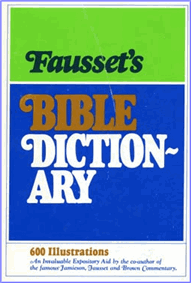Fausset's Bible Dictionary
A B C D E F G H I J K L M N O P Q R S T U V W X Y Z
Ashtoreth
The chief goddess of the Phoenicians, as Baal was the male. By the plural (ASHTAROTH, Baalim: Judges 10:6; 1 Samuel 7:4) different phases of the same deity, according to the different places of worship, are indicated. Always plural until under Solomon Ashtoreth or Astarte of Zidon was introduced (1 Kings 11:5; 1 Kings 11:3). She appears among the Philistines as the idol in whose temple they hung up Saul's armor (1 Samuel 31:10). She is identified as Ishtar or Nana, the planetary Venus among the Assyrian gods in inscriptions. Her name appears also in Cyprian and Carthaginian monuments; and on the sarcophagus of a king Esmunazar, who restored her temple at Zidon, along with his mother her priestess, Am-ashtoreth. She partly represents the planet Venus, partly the moon, "the queen of heaven" (Jeremiah 7:18; Jeremiah 44:17-18). (See ASHTEROTH-KARNAIM)
Our "star," Greek " aster," Latin stella, is akin. Her worship was most licentious and abominable; closely connected with that of frontASHERAH, "THE GROVE". Ashtoreh is the goddess, asherah "the grove," the image or the symbol of the goddess, of wood; asher, yashar, "to be straight," a straight stem of a tree living, or fixed upright (1 Kings 18:19; 2 Kings 21:7; 2 Kings 23:6; 2 Kings 23:13-14; 2 Kings 23:15; Judges 6:25; Judges 6:30). The "bringing out the asherah from the house of the Lord," and the "cutting down," suit such a symbol, not a grace in our sense. The active and passive powers of nature, generative and receptive, suggested the male and female deities, Baal and Ashtoreh. The ewes of a flock were called Ashteroth on this principle, propagating the flock (Deuteronomy 7:13).
The earliest worship of apostasy was that of the sun, moon, etc. This naturally was grafted on idol worship, Baal sometimes being the sun god, sometimes distinct (2 Kings 23:5). So Ashtoreh and the moon. The stone pillar was the symbol of Baal, as the sacred tree was the symbol of Ashtoreh; stone marking his strength as the male, the tree her fruitfulness (Deuteronomy 16:21). The sacred tree constantly accompanies the gods in the Assyrian monuments. In the Moabite Dibon stone the male form Astar is prefixed to Chamos or Chemosh, answering to the female Astarte. Identical with Athtar or Athtor of the Himyeritic inscriptions, and Estar of the Ninevite inscriptions; the Canaanite form of the male Aphroditos answering to the female Aphrodite.
Bibliography Information
Fausset, Andrew Robert M.A., D.D., "Definition for 'ashtoreth' Fausset's Bible Dictionary".
bible-history.com - Fausset's; 1878.
Copyright Information
© Fausset's Bible Dictionary
Fausset's Bible Dictionary Home
Bible History Online Home
Bible Encyclopedia (ISBE)
Online Bible (KJV)
Naves Topical Bible
Smith's Bible Dictionary
Easton's Bible Dictionary
Schaff's Bible Dictionary
Fausset's Bible Dictionary
Matthew Henry Bible Commentary
Hitchcock's Bible Dictionary

Dr. A.R. Fausset
Popular and Trending:
Meaning and definition of fasting, what is fasting in the bible, fasting definition, why should I fast, the power of prayer and fasting, Location of Galilee, where was galilee in the bible?, fasting definition, Galilee region, cities of Galilee, Sea of Galilee, Definition of biblical fire, what is fire in the bible?, fire and brimstone, fire meaning, baking bread with fire, Definition of the biblical firmament in Genesis, what is the firmament in the bible?, was the firmament the third heaven, firmament meaning, did the firmament bring the flood of Noah?.
